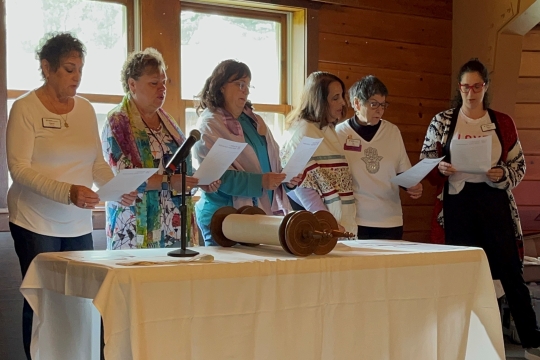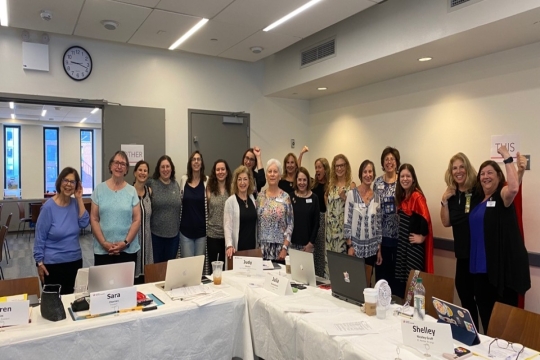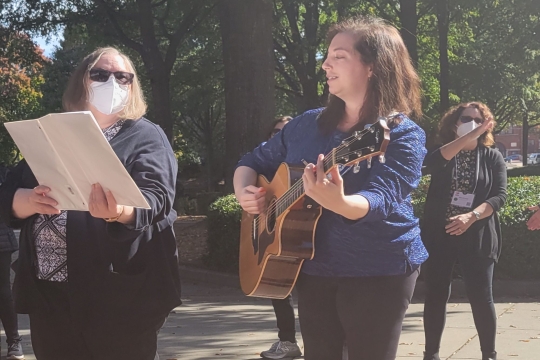
For thirty-one chapters in Deuteronomy, Moses has told the Israelites how to act. He has explained what God wants and has guided the Israelites, so their lives may be blessed. But now Moses is preparing to say goodbye. God told Moses to ascend Mount Nebo, where he would see the Promised Land and die. After 120 years, how will Moses – Moshe Rabbeinu – our greatest teacher, our revered prophet, address the Israelites?
This week’s Torah portion, Parashat Haazinu (Deuteronomy 32:1-52), focuses on Moses’ farewell. We might ask, what more is there to say? Moses gave 613 mitzvot of Torah to the Israelites and repeatedly impressed their responsibilities and consequences upon them. Yet Moses recognizes the significance of this occasion, of making final remarks to the Jewish people. Haazinu means “listen,” which, as we will see, we must do.
Not surprisingly, Moses seeks the widest possible audience for his grand finale. Directing remarks to celestial bodies and the Israelites, Moses calls upon heaven and earth – all of creation – to bear witness. “Listen, O Heavens, and I will speak! And let the earth hear the words of my mouth!” (Deuteronomy: 32:1)
Moses continues: “My lesson will drip like rain; my word will flow like dew; like storm winds on vegetation and like raindrops on grass.” (Deuteronomy 32:2). These are vivid, powerful, and sometimes dramatic images. Water and wind sustain our planet and make our very existence possible. Yet, unchecked, they can inflict great damage.
Moses’ message to the Israelites is similarly double-edged. As Moses reflects on the survival and destiny of the Jewish people, we can be uplifted by their endurance. Their impact on future generations validates the work of Moses’ 120-year lifetime. The covenant that the Israelites share with God remains intact. But prophet that he is, Moses also sees trouble ahead. He warns the Israelites that there will be challenging years, sometimes extreme hardship, because they cause God to “turn His face” from them. Like elements in the natural world, the Israelites can also wreak havoc if baser instincts prevail.
After likely frightening and unmooring the Israelites with a bleak description of their near extermination, Moses changes his tone. God cannot watch the annihilation of God’s chosen people. God must intervene to defeat those who drive the Israelites from their land to their death to further self-serving and corrupt agendas. Only with God’s help can the Israelites reclaim their land and survive. Moses foresees God’s involvement so that the Israelites could live on the land in the way that God had intended. Ultimately, the Jewish people survive.
Parashat Haazinu has been described as Moses’ testimonial, a poetic statement on the eve of his death. Like others who prepare testimonial statements, Moses draws from the past, pauses in the present, and sees into the future. His commentary is reflective, cautionary, and ultimately optimistic. Modern-day testimonials may be read by others or recorded by the author. The author can be filmed for an especially impactful experience. Moses, too, has a choice to make about how he will deliver his testimonial. How often have we heard something like “it’s not what you say, but how you say it” when we prepare for difficult private conversations or public presentations?
Moses makes an unexpected choice. He does not address the Israelites in the prose style we find throughout Deuteronomy and to which the Israelites would have been accustomed. Moses delivers his last prophecy in song (poetic verse). This is highly unusual. Almost all Torah text – 5852 verses – is written in prose style. There are only two examples of singing (poetic verse). They are “Song of the Sea “ (Exodus:15) and “Song of the Well” (Numbers: 21:16-18). And now there is “Song of Moses (Shirat Moshe).”
Music is vitally important to my worship experience. I enjoy listening to sacred music more widely. But I am not trained in music and am eager to learn more about Moses’ decision.
My research led to a blog post, “A Song You Will Remember,” in Reform Judasim.org, written by Cantor Elizabeth Sacks in October 2019. Cantor Sacks is Senior Cantor at Temple Emanuel, Denver, CO. There may be others, but this is the only article I find about “Song of Moses” as a musical composition. Commentaries on the text are readily available online.
Cantor Sacks tells us that “Song of Moses” is perceived “as magnificent and significant” and “is deeply rooted in Jewish tradition.” Our great sage Maimonides reports that in some communities, Haazinu is read daily. In recent years “Song of Moses” has made a top 10 list of music presented at critical times in Israel’s national life. Yet, Cantor Sacks points out that “Song of Moses” is not a typically grand, majestic, nor stirring nationalistic composition. Instead, “Song of Moses” is modestly constructed and does not rise to Moses’ vivid imagery.
For those who chant Torah, Cantor Sacks observes that “Of the 13 common musical phrases used throughout the rest of the Torah, the majority of the 43 verses of song in Parashat Haazinu (Deut. 32:1-43) employ only three of them. Moreover, those three phrases are musically the most unadorned phrases of the entire trope system: they are basic building blocks that contain very short musical expressions and barely deviate in pitch from the tonal center, the ‘home feeling’ of the musical structure.” These three musical phrases are combined in predictable patterns. More than half of the verses sound the same.
This did not sound like a complimentary assessment of Moses’ artistry to me. But as I read further, I learned that I did not recognize Moses’ genius. The simple repetitive melody is a vitally important strategic tool. It is the most effective way for Moses to focus the Israelites on his message. Moses understood the importance of repetition long before Professor Elizabeth Hellmuth Margulis of Princeton University explains the science behind the phenomenon in her award-winning book, On Repeat: How Music Plays the Mind (2014). Cantor Sacks draws on Margulis’ research to help us better understand the connection between repetition and what Moses wants to achieve.
Canter Sacks extrapolates from Margulis’ conclusions that appear in italics below.
- Repetition enables understanding. “Expected and familiar melodies” make it easier to understand and remember content quickly. Cantor Sacks believes that “As Moses’ time to depart draws near, he knows that he must convey his message economically and effectively.” He does so by relying on repetition.
- Repetition yields implicit participation. Cantor Sacks believes that listeners would have learned the repetitive musical pattern by the end of the sixth verse. They would have anticipated the remaining verses and been ready to sing. Participation empowers listeners. Wouldn’t Moses have wanted the Israelites to be energized by his farewell address?
- Repetition highlights deviation. In 43 verses of the “Song of Moses,” there are two significant musical deviations. The first is associated with the narrative shifting from God’s love to Israel’s ingratitude. The second is evident in establishing a key theme: God is Omnipotent. Moses draws the Israelites’ attention to these important places in his song by rarely punctuating the melody. Consequently, any change stands out.
- Repetition creates a lasting impression. Listeners learn what they have heard and then teach the song to others. Moses’ message to the Israelites will be remembered long after he is gone.
In closing, Cantor Sacks says: “As he prepares to depart from their presence, Moses employs a haunting, recurrent chant to ensure that the Israelites will understand, feel connected to, recognize the contours of, and eternally remember the wisdom he has gleaned from his life’s work. In this instance, simplicity itself is what breeds strength and staying power.”
And isn’t “strength and staying power” also key to the Israelites’ future and the enduring presence of the Jewish people?
Related Posts

Parashat Yom Rishon shel Rosh HaShanah

Cultivating a Culture of Accountability and Belonging

